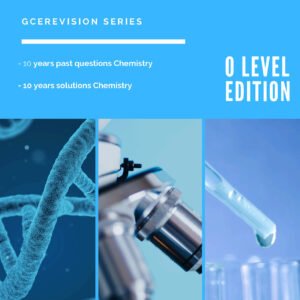G.C.E O/L Chemistry 2016 PAPER 2
| TWO hours This paper is arranged in two sections, A and B. Section A and Section B carry equal marks and it isrecommended that you spend about one hour on each section.Section A: You are advised to attempt ALL SIX questions; the mark awarded will be the total for your best FIVE answers.Section B: Answer ONLY TWO questions. ONE objective of this section is to give you the opportunity to organize material and present ideas, including calculations and diagrams where appropriate, in a clear and logical form. If you attempt more than TWO questions in this section, marks will be awarded only for the FIRST TWO.In calculations, you are advised to show all the steps in your working, giving your answer at eachstage Calculators are allowed.You are reminded of the necessity for good English and orderly presentation in your answers. |
|---|
USEFUL DATA:
Relative Atomic Masses 1 Faraday =96000C
Soduim (Na) = 23.0 Molar volume of a gas at r.t.p. is 24000cm3
Carbon (C) =12.0 Avogadro constant = 6.02×1023
Oxygen (O)=16.0 Specific Heat Capacity of water = 4.2Jg-10C-1
SECTION A: Answer ALL questions in this section.
1. The following table concerns some elements A-F. These letters are not the usual symbols of the elements.
| Elements | A | B | C | D | E | F |
| Atomic Number | 19 | 6 | 8 | 16 | 10 | 12 |
(a) Select from A to F
(i) An element with the most stable electronic structure:
(ii) Two elements that belong to the same group……….
(iii) An element that forms ions by loss of 2 electrons ……………
(iv) An element that would be classified first on the Periodic Table….. (4 marks)
(b) Using only the letters, write
(i) The formula of the compound formed between A and C.
……………………
(ii) An equation for the reaction between B and chlorine
…………………………………… (2 marks)
(c) Using electron-dot and cross diagrams only, show how bonding takes place in the compound formed
between B and D …….( 3marks)
(d) Select an element which could be extracted by electrolysis of its molten salt
……(1 mark)
Total 10 marks
2. Air is a mixture of elements and compounds.
(a) What is a mixture?
………………………………………… (1 mark)
(b) Complete the following table to give the composition of air.
| Elements in air | Compounds in air |
(2 marks)
(c) Identify the constituent of air that
(i) is removed when air is passed through aqueous sodium hydroxide………………………………………………..
(ii) is obtained from liquid air by fractional distillation………………………….(2 marks)
(d) Identify one other compound that is naturally introduced into the air by the action of lightening
…………………………………………………………………………………………………………………………………. (1 mark)
(e) Acid rain is becoming a major environmental problem in areas with polluted air.
(i) Identify one pollutant in air that causes acid rain……………………………………………………….
(ii) State one environmental hazard caused by acid rain…………………………………………………..
(2 marks)
(f) . Greenhouse effect is responsible for global warming. Name one gas in polluted air which is a major cause
of greenhouse effect and state its source.
Gas……………………………………………………….
Source………………………………………. (2marks)
Total 10 marks
3. Crude oil or petroleum is a mixture of hydrocarbons whose fractions can be separated by physical
means. Heavier and higher boiling point fractions can be cracked to give lighter fractions.
(a) What is a hydrocarbon?
(a) What is a hydrocarbon?
(b) (i). Name the method used to separate the components of crude oil.
(ii) Which principle is employed in this separation technique?
(c) (i) Define cracking
(ii) Write an equation to illustrate cracking
………………………………………………………………………………………………………………………………………. (2 marks)
(d) C3H8 and C3H6 are two organic compounds which belong to different homologous series.
(i) Identify the homologous series in each case:
C3H6………………………………………………………………………………………………………………………………………
C3H8………………………………………………….. …………………………………………………………………………………
(ii) Describe a chemical test that can be used to distinguish between C3H8 and C3H6
(4 marks)
(e) Give one environmental hazard of burning hydrocarbons.
(1 mark)
Total 10 marks
4. The following reagents are used in the laboratory and in the industry: Bromine water, acidified BaCL2,
NaOH (aq), AgNC3 (aq), Ca(OH)2(aq), Na2SCO4(aq), washing soda.
(a) Select a reagent that would be used to
(i) show the presence of bromide ions, an impurity in town water supply…………………………………………………
(ii) identify sulphate ions in solution ……………………………………………………………………………………………………
(iii) distinguish between ethene and ethane …………………………………………………………………………………………..
(iv) detect the presence of Fe2+ ions in impure water ……………………………………………………………………………..
(v) test for carbon dioxide gas ……………………………………………………………………………………………………………
(5 marks)
(b) One of the reagents is used for water treatment.
(i) Identify the reagent ………………………………………………………………………………………………….
(ii) State its function ……………………………………………………………………………………………………..
……………………………………………………………………………………………………………………………….. (2 marks)
(c) Two of the reagents are commonly used in the laboratory to prepare an insoluble salt.
(i) Identify the two reagents
1……………………………………………………………………………………………………………………………………………….
2………………………………………………………………………………………………………………………………………………………
(ii) Write an equation for the formation of the salt
(iii) How would you obtain a pure, dry sample of the salt?
(3 marks)
Total 10 marks
5. A current of 1.5 A is passed through potassium hydroxide solution for one hour thirty minutes using inert
electrodes.
(a) Draw a simple electrolytic cell used. (2 marks)
(b) Calculate the quantity of electricity passed in Coulombs.
(2 marks)
(c) (i) Identify the gases produced at each electrode
Cathode: …………………………………………………….
(ii) Write equations for the reactions at the electrodes.
Cathode: ……………………………………………………………..
Anode: ………………………………………………………………..
(4 marks)
(d) When the gases produced at each electrode are ignited, a reaction occurs. Write an equation for the reaction.
(1 mark)
(e) State one industrial application of electrolysis.
………………………………………………………………………….. (1 mark)
Total 10 marks
6. This question is on the rates of chemical reactions.
Consider equations 1, 2 and 3 below:
1. CaCO3(s) + 2HC1 (aq)——– CaCl2 (aq) + H2O(l) + CO2(g)
2. N2(g) + 3H2(g) ——-2NH3(g)
3. 2NaOH (aq) + H2SO4 (aq) ——-Na2SO4 (aq) + 2H2O (l)
(a) Define “rate of a reaction”
(1 mark)
(b) List any four factors that will affect the rates of the reactions above.
(2 marks)
(c) State and briefly explain any two things that can be done to increase the rate of reaction 1 above.
1 ………………………………………………………………….. .. ……….. … ………………………………………………………..
Explanation:………………………………………………………………………………………………………………………………
2: ……………………………………………………………………………………………………………………………………………………………………
Explanation:………………………………………………………………………………………………………………………………
(4 marks)
(d) Which of the factors that affect rates of reactions will affect reaction 2 but not reaction 3?
(1 mark)
Briefly describe how the gas produced in reaction can be identified.
(2 marks)
Total 10 marks
SECTION B:
Answer any TWO questions. All questions carry equal marks. Write your answers on the lined papers that
follow this section. Where appropriate, equations and diagrams should be given to clarify your answer.
7. (a) Define a standard solution.
Describe how you would prepare 0.5M Na2C03 solution using a 250cm3 volumetric flask and use it to determine
the concentration of dilute hydrochloric acid. Your description should go as far as collection of data.
(b) In one of such experiment, 25.0cm3 of 0.5MNa2CO3 completely neutralised 50.0cm3 of the solution of dilute
hydrochloric acid. Calculate the molarity of the acid solution in mol/dm3
(25 marks)
8. Write short notes on the following
(a) Addition reaction
(b) Substitution reaction
(c) Condensation polymerisation
(d) Saponification
(e) Esterification.
(25 marks)
9. Salts are generally prepared in the laboratory by the following methods.
(a) Action of dilute acids on metals
(b) Action of dilute acids on metal oxides
(c) Action of dilute acids on alkalis
For each method, choose a suitable salt and describe how a pure solid sample of each salt is prepared. Your
description should show clearly the starting material, the necessary equations and precautions.
(25 marks)
10. Bridge construction and distribution of electricity by use of overhead cables are important activities in Cameroon.
(a) For each activity select the metal used and describe how it is extracted from a named ore.
(b) Give the property of each metal that enables it to be used in the named activity.
(25 marks)








koumene charnelle
January 9, 2019
Very goog please continue helping our younger one's
T- frank
January 9, 2019
ok thats our priority ..i appreciate that!
koumene charnelle
January 9, 2019
Thanks for helping
T- frank
January 9, 2019
you are very much welcomed Charnelle!
ofang Karel
April 14, 2019
Textareaplz for Cameroon gce o level chemistry 2010,2011,2013,2014 and 2015
Jordy
June 2, 2019
Answers please for short notes on saponification, addition reaction and fermentation
Dobdingha Randy Forkwa
December 26, 2019
Awesome and unique thanks
Tchanks
February 22, 2022
Fine